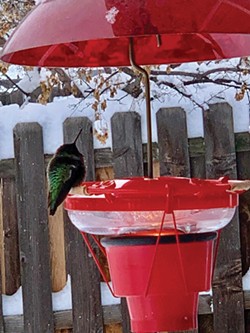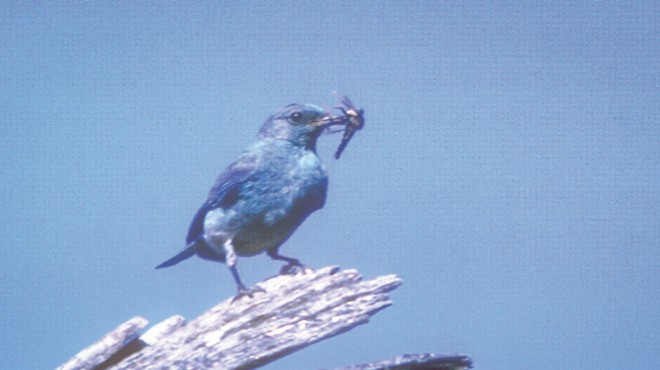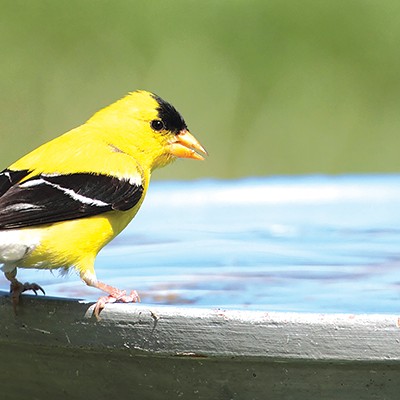As remarkable as it sounds, hummingbirds overwinter in Central Oregon. These toughies are Anna's hummingbirds and are amazingly stout for their 4-4.5-gram size. These green gems have expanded their range into hotter and colder climates over the last 20 years. Yet, they face real trouble in deep freeze, blizzard conditions and icy rain. There are several easy ways to help them survive.
How do hummingbirds survive intense weather?
Due to their petite size, hummingbirds must feed every 10-15 minutes, or they can starve. These quaint birds use a handy mini-hibernation called torpor to survive periods of not eating, like night-time sleep. In this state, they slow their metabolism and lower their body temperature. They literally choose to be cold rather than use energy reserves to stay warm. On a warm night, hummingbirds enter a lighter torpor stage to survive.
During freezing weather, they may be forced into a deeper torpor state at night and during the day. You may see these birds sitting stoically still at the feeder, they might even appear dead. These birds take up to a half hour to recover from this state, so they risk predation, injury (like falling into the snow) and even death. Never wake a bird in torpor in the early morning.
Signs of a bird in trouble include the bird being in an unusual location, like tucked into a porch, hanging upside down for long periods, having body parts frozen to the feeder, dropping out of the air, falling from the feeder or just sitting and not eating for extended periods.
tweet this
Frequent or constant states of deep torpor can become a deadly cycle in which the bird goes for hours without eating. They can starve in a day if not refueled with nectar (feeder solutions, flower nectar or sap). Since these birds also eat insects, malnutrition can occur if they do not find this protein source. Hummingbirds need nectar to forage for insects; they cannot survive without nectar or insects.
Hummingbird challenges
Little birds enduring winter have challenges maintaining heat due to having less body mass than larger birds. For warmth, they rely on air, warmed by their body and trapped in their downy feathers. But hummingbirds have less down than other birds and less fat than larger birds. Health and available food directly impact any bird's survival. Parasites, low body fat, low body weight and inexperience put them at risk. Other risks include windows and predators. Birds in frequent torpor preen (groom) less, leaving feathers dirty and reducing their insulating abilities.
While many of our Anna's will defy winter's threats, some of these wee hummingbirds will have real issues staving off super frigid temperatures and finding enough food.

How to help your hummingbirds
Hummingbirds need food most; they can also use warmth in the deepest cold. Keeping hummingbird feeder solutions tepid and thawed is paramount. Icy feeder solution lowers the internal body temperature, so warmer solutions help. Two common ways are feeder heaters and heat lamps. Please be cautious about safety for you and the birds (many ideas don't work or are dangerous).
Put the feeder in a protected and warmer area, such as under the house eaves and where the sun hits (not in front of windows, though).
There are essential rules to follow if you feed your hummingbird friends. Keeping their feeder clean and the solution fresh is vital to avoid disease and bacterial infections. Only use a 4:1 water-to-sugar solution in Central Oregon, not 3:1, which is dehydrating. (Editor's note: the print edition of this story stated a 4:1 sugar-to-water ratio; that was incorrect. It's "water to sugar." We regret the error.)
Please do not keep a frozen and unmanaged feeder out; it uses critical energy as they hunt for thawed feeders.
Signs of a bird in trouble include the bird being in an unusual location, like tucked into a porch, hanging upside down for long periods, having body parts frozen to the feeder, dropping out of the air, falling from the feeder or just sitting and not eating for extended periods. These struggling birds' feathering may also look bedraggled. 2024 is Native Bird Care's 15th year providing specialized hummingbird care. For more ideas on what to do and specific situations of concern, don't hesitate to contact us or visit our website.
— Elise Wolf directs and is the permitted rehabilitator for Native Bird Care, an avian rescue specializing in hummingbirds and songbirds. nativebirdcare.org. Text: 541-728-8208
























